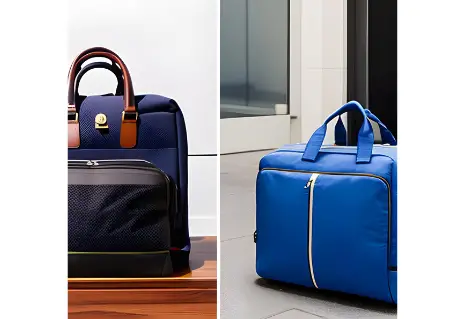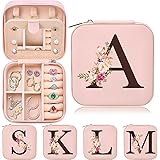Are you struggling to figure out if a carry-on or a personal item is the right choice for your next flight? In this blog we will compare the two, and help you decide what is best for you. A carry-on item is one piece of luggage that is placed in an overhead bin for storage, while a personal item is stored under the seat in front of you.
Both of these come with a few advantages and disadvantages, so we will carefully analyse them both to help you make the right decision. We will look at elements such as the size of what you can bring, the costs associated with them and more. By the end of this blog, you will have all the answers you need about carry-on vs personal item.
Table of Contents
A Brief Comparison Table of a Carry-On versus a Personal Item
| Specification | Carry-On | Personal Item |
|---|---|---|
| Size Limit | Each airline has different size limitations for carry-on luggage. Generally speaking, the maximum combined length, height, and width should be approximately 45 inches. | The limited size of personal items does not exceed 45 linear inches (length + width + height) and should fit underneath the seat in front of you. |
| Weight Limit | The permissible weight of luggage for a carry-on may range between 15 to 20 lbs. | Maximum weight is generally 10 to 15 lbs. |
| Where is It Stored | Most airlines allow passengers to keep carry-on bags in the overhead compartments above their seats. | On the other hand, personal items are usually kept underneath the seat in front of passengers. |
| Examples | The usual items included in a carry-on bag are laptop case, purse, backpack, or briefcase. | Personal items refer to a small bag, laptop bag, women’s handbag, an umbrella, or a baby bag, for example. |
| Extra Fees | There are often extra charges for overweight items. | Most airlines do not charge for a personal item. |
| Amount Per Person | Generally, passengers can bring one carry-on bag with dimensions not exceeding 45 linear inches. | Passengers can bring one personal item in addition to their carry-on bag. |
The debate over carry-on versus personal items has been ongoing, and all airlines have different rules and regulations for transporting belongings on flights. It’s smooth sailing once you know the size limit, weight limit, storage location and examples of each. A carry-on item is the bag that you take on board the flight in the overhead compartment.
The bag must fit the airline’s designated size and weight limits. On the other hand, a personal item is often a small bag, laptop bag, laptop, purse, backpack, briefcase, camera, umbrella, or a baby bag, which may be placed under a seat, inside a pocket located on the back of the flight seat, or inside drawers below the seat in front.
Most airlines allow passengers to bring one carry-on bag, with the weight usually not exceeding 20 pounds and dimensions not exceeding 45 linear inches. On the other hand, the limited size of a personal item does not exceed 45 linear inches and should fit underneath the seat in front of you. Most airlines do not charge for a personal item and instead charge for overweight items.
However, extra charges in the form of a pet fee or over-weight bag fee may be applicable for certain items, and this varies based on each airline policy. It is wise to know the airline policies and learn the rules so that checking in will be a stress-free process.
Overall, it is important to adhere to the specific policies each airline stipulates regarding carry-on and personal baggage. By understanding the size limit, weight limit, storage location and examples of each of these items, passengers can make smart and informed decisions when preparing for their trips.
Carry on vs Personal Item: What You Need to Know
When you travel, it’s important to make sure you are prepared with all the necessities you need while still adhering to the restrictions and rules set by the airline you are flying with. Depending on the airline, there may be restrictions on the size of carry-on bags or bags that can or cannot be taken as personal items.
To help you make sure you’re following all the regulations and not wasting money on paying fees for oversized bags, let’s explore the differences between a carry on bag and a personal item in detail.
Carry On Bags
A carry-on bag is any bag or piece of luggage that must be taken with you on the plane and stored in the overhead bins upon boarding. These bags must adhere to size and weight restrictions that are specific to the airline you are flying with. Most airlines will allow for one carry-on bag plus one personal item.
When it comes to size, all airlines have specific carry-on dimensions. Generally speaking, the maximum size of a full-size carry-on bag is approximately 22x14x9 inches and should weigh a maximum of 40lbs. Airlines may also set specific restrictions on wheeled bags and non-wheeled bags in terms of their size and weight as well.
So it’s iimportant to consult the rules of the airline you’re flying with prior to boarding.
If you are found to have a bag that is oversized or too heavy for carry-on restrictions, you may be charged an excess baggage fee.
Personal Items
In addition to a carry-on bag, you are also generally allowed to take one personal item with you on the plane. But, like carry-on bags, personal items are subject to size and weight restrictions based on the airline and policy.
A personal item is smaller than a full-size carry-on bag and can include small backpacks, purses, briefcases, laptop bags, or camera bags. Generally, your personal item should not be taller than 18-inches, longer than 14-inches, or wider than 8 inches and the maximum weight should be around 18lbs.
Anything that does not fit in this size range is likely to be considered a full-size carry-on bag.
When travelling, its important to make sure that this personal item easily fits under the seat in front of you. If it is too large it may be considered a full-size carry-on bag, which may result in you being charged an excess baggage fee.
If you are unsure whether or not an item will fit on the plane, it’s best to adhere to the size guidelines and opt for smaller or travel-size items. You can also call the airline’s customer service line with any questions you have about what items are legally able to be taken as a carry on bag or personal item.
What You Can Pack in Your Bag
When it comes to what you can actually pack in your carry on and personal items, the restrictions and rules may vary by airline.
Generally speaking, all airlines will restrict liquids from being taken as a carry-on. This means all liquids and gels including shampoo, sunscreen, makeup, and liquid toiletries that are over 4 oz must be packed in checked bags.
Anything sharp like knives, razor blades, scissors, tools, or ice skates should also be packed in checked luggage where they can’t harm anyone during the flight. Fragrances and perfumes that are larger than 3.4 ounces can also not be taken as carry-ons.
Other items to note are items that are ONLY allowed to be taken as carry-ons. Anything containing precious metals or gems, valuable items, electronics, medication, or any items that need to be accessible during your flight should be taken as a carry-on.
Can I Bring Two Carry-on Bags?
This all depends on the airline. Generally speaking, most airlines only allow for one carry-on bag plus one personal item. Flying in first or business class may also entitle you to bring two carry-on bags, but this is all dependent on the airline policy.
To avoid any confusion during the boarding process, it’s best to double-check with your airline to see if they allow for two carry-ons. Additional carry-on and personal items are typically subject to an excess baggage fee.
Are There Other Types of Bags?
Yes, there are a few other types of carry-on size bags which are typically allowed to be brought on planes without having to pay an excess baggage fee.
The first is any type of bag that falls into the category of duty or cabin-free bags. These bags are typically used by passengers who are on official business and need to bring items with them on the plane for their job. These bags are typically a backpack or other type of bag that can fit your laptop and other items.
Pet carriers, garment or collapsible garment bags, and smaller wheeled suitcases are also typically allowed without additional fees. Pet carriers are for the transportation of small dogs and cats and have a maximum allowance of 16 inches in length and 8 inches in width.
Collapsible garment bags are usually appended to checked luggage or wheeled suitcases and should not be larger than 45 linear inches.
What Are the Benefits of Taking a Carry-on?
There are many benefits to taking a carry-on bag, the primary one being that you will save money on checked baggage fees. When you take your items as carry-ons, you won’t have to worry about excess baggage fees. You also have access to all of your items, so you don’t have to wait at the baggage carousel or worry about your items being lost in transit.
Carry-on bags also cut down on the time spent at the airport. You won’t have to drop your bags off or wait for them when it’s time to board the plane, and you don’t have to worry about any issues with your checked luggage. Getting on the plane with all of your items is also a much safer option for your possessions.
When travelling, it’s important to make sure you understand the rules and regulations set by the airline you’re flying with. This means you must adhere to the size and weight restrictions set for both carry-on bags and personal items. Taking a carry-on bag can save you money on checked baggage fees, as well as keeping your items safe and secure during your travels.
Key Differences Between Carry-On and Personal Item
When planning for air travel, one of the most important considerations is baggage. Although airlines differ on their exact policies, carry-on and personal item are generally allowed on most flights.
Each of these luggage options has its own specifications and restrictions, and understanding the key differences between the two is essential to ensure optimal baggage storage space and comfort during flight.
Size and Dimensions:
One of the most significant differences between carry-on and personal item is size and dimensions. Depending on the airline, carry-on bags are typically allowed to measure 55cm x 40cm x 23cm (including the wheels and handles) and weigh no more than 10kg. Personal items, on the other hand, vary in size but usually must fit comfortably under the seat in front. They should not exceed the size and weight of a standard laptop bag, briefcase or tote.
Storage Space:
Another key difference between carry-on and personal item is storage space. Generally, carry-on bags are allowed in the overhead cabin storage compartment, while personal items must be stored under the seat in front of you. As a result, personal items are subject to space limitations, meaning that travelers should plan wisely when packing.
Contents:
In terms of contents, the two luggage options differ greatly. As a rule of thumb, carry-on bags are likely to contain your most important and delicate belongings such as jewelry, cameras, and laptops. Personal items, on the other hand, can contain a variety of items such as books, magazines, a few clothing items, a wallet, and other small accessories.
Cost and Fees:
Cost and fees are another key difference between carry-on and personal item. Since carry-on bags have a much higher storage capacity and can hold larger items, airlines typically charge a fee to check them in on flights.In comparison, personal items are usually free to bring on board. As a result, travelers should make sure that their carry-on meets the airline’s weight and size restrictions before paying additional fees.
Usability:
Last, but not least, another key distinction between carry-on and personal items is their usability. Carry-on bags are designed to be taken on the flight and used during the journey. On the other hand, personal items are more suitable for storing items such as paperwork or documents that may need to be accessed during the flight and can often be safely stowed away while in the air.
Overall, there are a number of key differences between carry-on and personal items when it comes to size, storage, contents, cost, and usability. Understanding these distinctions can help travelers plan and pack their bags properly for an optimal and comfortable flying experience.
FAQs – Carry on vs Personal Item
A carry-on item is a bag or suitcase that fits in the overhead bin of an airplane, while a personal item is a bag (such as a purse) or other item that must be stored under the seat in front of you. Generally, personal items are much smaller than carry-on items.
Yes, most airlines allow you to bring a carry-on and a personal item on your flight. However, different airlines have different rules about what counts as a carry-on item and what counts as a personal item, so it’s important to check with your airline before you travel.
Generally, a personal item can include items such as a purse, backpack, laptop bag, or briefcase. Some airlines also allow other items such as a camera, a coat, an umbrella, or a book. It’s important to check with your airline before you travel to make sure your item is permitted.
A carry-on item can generally include items such as clothing, toiletries, laptop, camera, and any other items necessary for your journey. However, it’s important to check with your airline to make sure that all of your items meet their guidelines.
Yes, there are certain items that are not permitted in a carry-on, such as guns, explosives, and flammable materials. Additionally, some airlines have size and weight restrictions on carry-on items, so it’s important to check with your airline before you travel.
Yes, generally items such as guns, explosives, and flammable materials are not permitted in a personal item. Additionally, some airlines have size and weight restrictions on personal items, so it’s important to check with your airline before you travel.
Most airlines provide guidelines for what qualifies as a carry-on item, including size and weight restrictions. It’s important to check with your airline before you travel to make sure your item meets the guidelines.
Some airlines may charge a fee for bringing a carry-on, so it’s important to check with your airline before you travel. Additionally, it’s important to make sure your carry-on item meets the size and weight restrictions of your airline.
Wrapping Things Up
When deciding on what to take with you on your next flight, it is important to decide whether the item should be placed in your hand luggage or your personal item. Carrying on items is advantageous since it prevents them from being delayed or lost during the journey. In contrast, having a personal item allows you to bring extra items with you on the flight. Ultimately, you should consider the size of the item and your final destination in order to determine whether to carry it on or put it in your personal item.
No matter what you decide to do, remember that you should always prioritize your safety above convenience when travelling with airlines. Keep your items secure, and plan accordingly in order to make the most of your experience. Carry-on vs personal item can both be useful if used responsibly and within guidelines.






